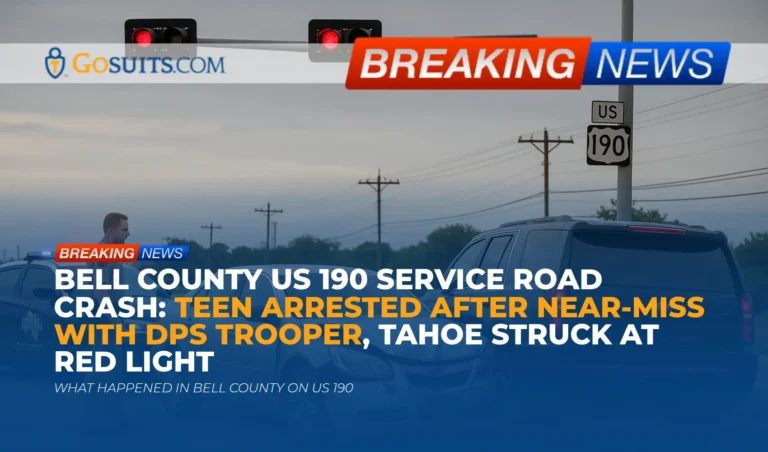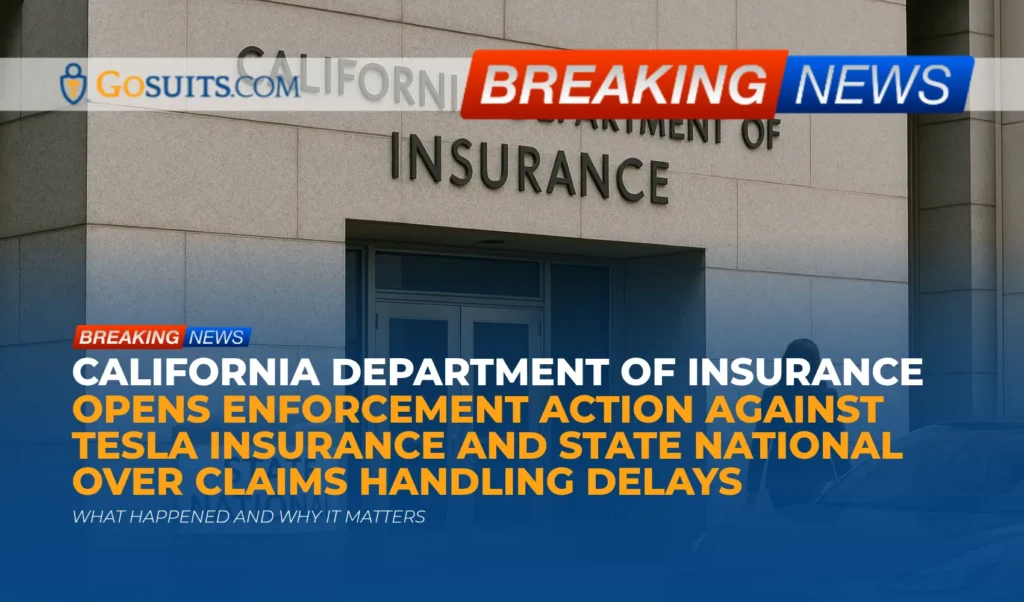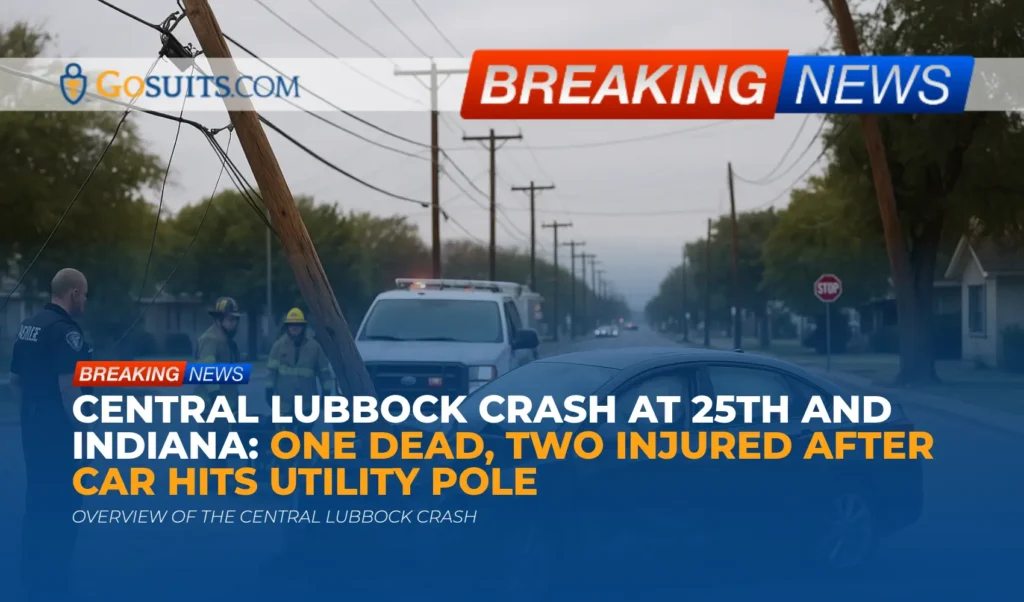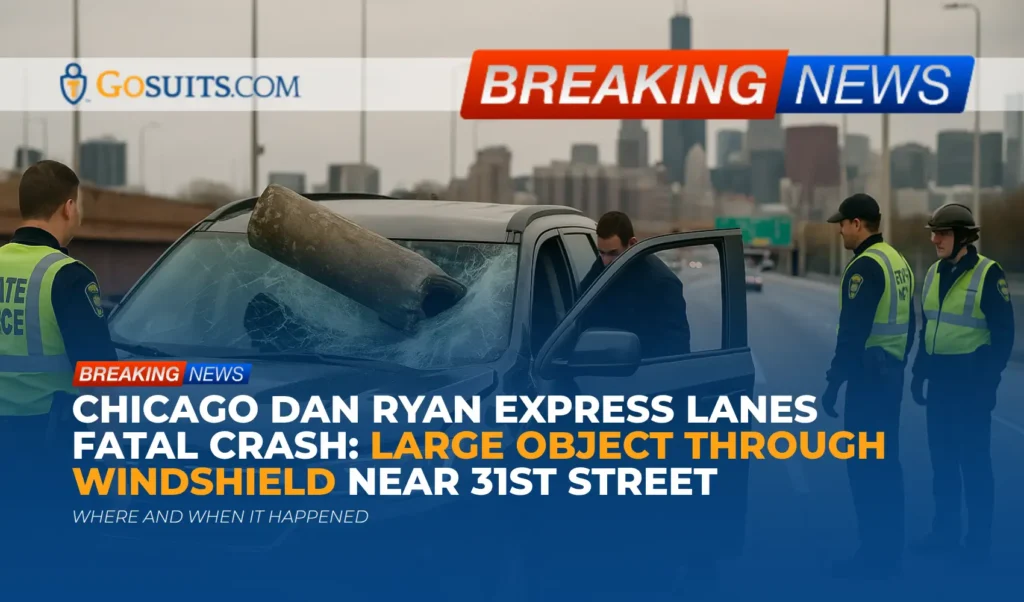- What Happened in Bell County on US 190
- Known Facts and What Remains Unclear
- Why This Matters: Safety and Civil Legal Context in Texas
- Potential Civil Liability After a Red-Light Collision
- Insurance Considerations After a Texas Intersection Crash
- How to Get Official Records and Who to Contact
- Preserving Evidence and Documenting Impacts
- Time Limits and Notice Rules in Texas
- Government Data Highlights on Intersection and Teen-Driver Crashes
- Practical Steps After a Similar Incident
- Commentary from Gosuits Bell County, Texas Personal Injury Attorney
- Important Next Steps for Central Texas Drivers and Passengers
What Happened in Bell County on US 190
According to information reported by state authorities, a 17-year-old driver in a 2009 Chevrolet Malibu nearly struck a Texas Department of Public Safety (DPS) trooper’s patrol vehicle during routine patrol on US 190 in Bell County. The near-collision was attributed to an unsafe lane change that required the trooper to take evasive action. When the trooper activated emergency lights to initiate a traffic stop, the Malibu reportedly failed to yield and continued driving. As the vehicle approached the intersection of the US 190 service road and Jasper Road around 7:21 a.m., the driver lost control and collided with a 2016 Chevrolet Tahoe that was stopped at a red light.
Law enforcement stated the teenage driver was not injured and was arrested after the crash. The Tahoe’s driver, age 27, and two young passengers (ages 3 and 1) were reported uninjured at the scene. Authorities indicated the teen was taken to the Bell County Jail following the incident.
Known Facts and What Remains Unclear
What is known:
- Location: US 190 service road at Jasper Road in Bell County, Texas.
- Time: Approximately 7:21 a.m.
- Involved vehicles: 2009 Chevrolet Malibu and 2016 Chevrolet Tahoe; a DPS trooper’s vehicle was nearly struck but not involved in the collision itself.
- Injuries: No injuries reported to the Malibu driver; Tahoe driver and two child passengers reported uninjured.
- Law enforcement actions: DPS trooper attempted to initiate a traffic stop; collision occurred at the red light; the teen driver was arrested afterward.
What is not yet known (and may be clarified by official reports):
- Precise speeds of the vehicles and timing of signals at the intersection.
- Dashcam or body-worn camera footage details, if any, from the trooper’s vehicle.
- The scope of vehicle damage, medical evaluations post-scene, and any delayed symptoms for those involved.
- Insurance carriers for each party and coverage limits.
Because early accounts can be incomplete, the official Texas crash report and any supplemental materials are the best sources for authoritative details about conditions, witness statements, and diagrammed movements of the vehicles.
Why This Matters: Safety and Civil Legal Context in Texas
This crash thread highlights several important safety and civil law issues in Texas:
- Unsafe lane changes and failure to yield can create unpredictable hazards, especially near highway service roads where speeds and merges vary. The Texas Driver Handbook explains that drivers must signal, check mirrors, and ensure a lane is clear before moving over, yielding appropriately where required. See the Texas Driver Handbook from the Texas Department of Public Safety for fundamental right-of-way and lane-change rules (dps.texas.gov).
- Intersection crashes remain a major safety concern nationwide. NHTSA notes that red-light running crashes kill hundreds of people annually, including many who were not the violators (drivers or passengers in other vehicles, pedestrians, and cyclists). See NHTSA’s red-light running overview (nhtsa.gov).
- Teens behind the wheel face elevated risk due to inexperience, especially during congested or complex driving environments such as multi-lane highways and intersections. The CDC provides research-based insights on teen driver risk and prevention strategies (cdc.gov).
From a civil perspective, even when immediate injuries are not apparent, occupants can experience delayed symptoms. Children, in particular, may have difficulty communicating discomfort. It is prudent to monitor for signs of soreness, headache, changes in behavior, or sleep disturbances after a collision, and to seek medical evaluation if concerns arise. While nothing here is medical advice, prompt documentation of any symptoms can support appropriate care and any related insurance claims.
Potential Civil Liability After a Red-Light Collision
In Texas, the party whose negligence causes a crash can be held financially responsible for resulting harms. Broadly, negligence is failing to use reasonable care under the circumstances. Based on the facts reported so far, a civil analysis may consider:
- Unsafe lane change and control: Allegations that a driver made an unsafe lane change and later lost control near a signalized intersection can support claims of negligence if those actions are shown to have caused a crash and damages.
- Failure to yield to emergency signals: When a patrol vehicle activates emergency lights to initiate a stop, civil disputes sometimes examine whether continued driving contributed to the sequence of events that followed. While the criminal aspects are separate, the same facts may be relevant in a civil negligence case.
- Rearward and cross-traffic protections at red lights: Vehicles stopped at a red light are generally protected by rules governing right-of-way and signal obedience. A collision into a lawfully stopped vehicle commonly raises a presumption of negligence, subject to case-specific proof.
- Vicarious liability and negligent entrustment: If the at-fault driver does not own the vehicle, the owner’s liability may be considered under theories such as negligent entrustment if they knowingly allowed an unsafe or unlicensed person to drive. Whether those facts apply requires investigation.
No two cases are identical. Liability can be impacted by roadway design, visibility, signal timing, and whether any party’s conduct was a contributing factor. The official CR-3 crash report, scene photos, and witness statements are critical to analyzing civil responsibility.
Insurance Considerations After a Texas Intersection Crash
Texas law requires drivers to show proof they can pay for the accidents they cause, most often by carrying liability insurance. The Texas Department of Insurance explains the minimum required liability limits are often referred to as 30/60/25, meaning at least $30,000 per person for injuries, up to $60,000 per crash for injuries, and $25,000 for property damage. See TDI’s consumer auto insurance resources (tdi.texas.gov).
Key coverages to understand:
- At-fault driver’s liability coverage: Typically pays for other people’s injuries and property damage when the insured is legally responsible.
- Personal Injury Protection (PIP): In Texas, PIP is automatically included unless rejected in writing. It can help with medical bills and certain lost income, regardless of fault. See TDI’s explanations of PIP and medical payments coverage (tdi.texas.gov).
- Medical Payments (MedPay): Optional coverage that can help with medical expenses regardless of fault.
- Uninsured/Underinsured Motorist (UM/UIM): Helps when the at-fault driver has no insurance or not enough to cover losses.
Property damage considerations:
- Vehicle repairs and total loss: Liability insurance of the at-fault driver may cover repair costs or the actual cash value if declared a total loss. Keep all estimates and invoices.
- Child safety seats: NHTSA advises replacing car seats after certain crashes; their guidance explains when replacement is recommended (nhtsa.gov). Document the make, model, and crash details for reimbursement requests.
- Personal items in the vehicle: Some policies cover damaged personal property; check policy terms.
Important caution before contacting insurance companies: Individuals often feel pressure to give recorded statements quickly. It is generally wise to consult with an attorney first. Statements given to an insurance carrier can be used to limit or deny a future claim. A brief consultation can help you understand your rights, the scope of coverages, and how to avoid common pitfalls.
How to Get Official Records and Who to Contact
To understand exactly what happened, official records are essential. In Texas, the primary documents include the CR-3 crash report, photographs, and in some cases video.
Crash report (CR-3)
- Purchase the official Texas crash report through TxDOT’s Crash Records Information System (CRIS). You can search and purchase available reports here: cris.dot.state.tx.us.
- CR-3 reports typically include parties involved, diagram, contributing factors, citations (if any), and narratives from the investigating officer.
Dashcam or related DPS records
- Requests for records held by the Texas Department of Public Safety, such as patrol vehicle video, are generally made under the Texas Public Information Act (PIA). Start at DPS’s public information request page: dps.texas.gov.
- Some records may be restricted or partially redacted under Texas law. The Texas Attorney General provides guidance on what information may be protected: texasattorneygeneral.gov.
If a serious injury or death occurs
- In some Texas counties without a medical examiner, justices of the peace conduct inquests. Relevant statutes are in the Texas Code of Criminal Procedure, Chapter 49 (statutes.capitol.texas.gov).
- For fatal crashes, next of kin can ask the appropriate county authority about autopsy reports and timelines. Availability depends on the status of any ongoing investigations and statutory privacy rules.
Tip: Keep copies of any requests and receipts. If you hire counsel, provide these materials so they can coordinate additional requests or subpoenas if needed.
Preserving Evidence and Documenting Impacts
Clear documentation reduces disputes and helps decision-makers understand what happened.
- Photographs and video: Capture the intersection, signal heads, lane markings, tire marks, debris, and each vehicle’s damage from multiple angles. If safe, photograph the position of vehicles before they are moved.
- Witness information: Gather names and contact details of bystanders, other drivers, and nearby workers who saw the events.
- Vehicle data: Some vehicles store event data that can shed light on speed and braking. Preserve the vehicle and consult a professional about retrieving this information if the case is serious.
- Medical evaluations: Even if you feel fine, consider an evaluation soon after the crash. Keep all discharge papers, referrals, and receipts for medications or therapy.
- Child passengers: Monitor for changes in mood, sleep, appetite, or activity that might suggest discomfort or stress after a crash. Keep a simple log of observations and any pediatrician visits.
- Employment and daily life: Track missed work, appointments, and activities that became difficult due to post-crash issues. Contemporaneous notes carry weight.
- Insurance communications: Save every letter and email; note dates and times of calls and the names of claim representatives.

Time Limits and Notice Rules in Texas
Texas has deadlines for bringing civil claims and special notice requirements for claims involving government entities. Missing these can affect your options.
- General limitation periods: Texas law generally provides two years to file a lawsuit for personal injury or property damage arising from a motor vehicle crash. See Texas Civil Practice and Remedies Code §16.003 (statutes.capitol.texas.gov).
- Claims involving a governmental unit: If a claim involves a governmental unit, the Texas Tort Claims Act requires written notice within six months of the incident, describing the damage or injury, time and place, and the incident itself, unless a city’s charter requires earlier notice. See §101.101 (statutes.capitol.texas.gov). This is a complex area with exceptions and limitations on recoverable damages.
If there is any possibility a governmental entity is involved, consider seeking guidance promptly so notice letters, preservation requests, and independent investigations can happen in time.
Government Data Highlights on Intersection and Teen-Driver Crashes
Government research underscores why careful driving and quick response after a crash matter:
- Red-light running harms many who did nothing wrong. NHTSA reports that hundreds of people die each year in crashes involving red-light running, and a significant share of those killed are pedestrians, bicyclists, and occupants of other vehicles. See NHTSA’s red-light running resource (nhtsa.gov).
- Teen drivers face elevated crash risk. The CDC notes motor vehicle crashes are a leading cause of death for U.S. teens; risk increases with inexperience, night driving, and when teen passengers are present. Graduated licensing strategies and parental involvement reduce risk (cdc.gov).
- Intersection safety remains a federal priority. The Federal Highway Administration has promoted proven countermeasures, such as improved signal visibility, backplates with retroreflective borders, and better access management to reduce conflicts (highways.dot.gov).
While roadway design matters, the immediate cause in many intersection crashes remains driver behavior: attention, yielding, speed management, and proper lane changes. These human factors align closely with what is described in the Bell County incident.
Practical Steps After a Similar Incident
When a vehicle stopped at a red light is struck, the occupants often feel a mix of shock and uncertainty. The following steps can help protect well-being and legal options:
- Safety first: Move to a safe area if possible and check everyone for injuries. Call 911 to request police and any needed medical support.
- Ask for the investigating agency and report number: If a state trooper investigated, ask which DPS region handled the incident and the report number. This makes obtaining the CR-3 faster.
- Photograph the scene: Capture the intersection layout, signal lights, lane markings, vehicle positions, and any skid or yaw marks.
- Document traffic signal phases if possible: Note if left-turn arrows or pedestrian signals were active; such observations can help reconstruct events.
- Medical follow-up: Seek evaluation even if symptoms are mild. Keep all records together in one folder.
- Child safety seats: Review NHTSA’s guidance on whether to replace child restraints after the crash (nhtsa.gov). Keep purchase receipts and photos of the seats installed in the vehicle at the time of the crash.
- Vehicle towing and storage: Note where the vehicle is taken, daily storage rates, and any deadlines for removing personal items.
- Insurance communications: Before giving recorded statements, consider speaking with a lawyer. Statements can affect how insurers evaluate fault and damages.
- Request official records: Purchase the CR-3 via TxDOT CRIS (cris.dot.state.tx.us) and consider a DPS public information request for available video (dps.texas.gov).
Commentary from Gosuits Bell County, Texas Personal Injury Attorney
We are relieved to hear that the adults and small children in the SUV were reported uninjured. Crashes at intersections especially those involving families on their morning routines can leave a lasting emotional impact even when injuries are not immediately obvious. This article is meant to provide educational, general information to help the community understand the civil side of incidents like this one.
Based on what has been publicly described, a sequence of unsafe lane movement, a near-miss with a patrol vehicle, and loss of control near a red light culminated in a collision with a stopped SUV. From a civil perspective, this paints a familiar picture: a preventable event with potential claims for vehicle damage, replacement of child restraints if required, and medical follow-up if symptoms arise later. The official crash report and any available patrol video are vital to clarify the timeline and driver actions.
Insurance companies and large corporate carriers often move quickly to contain their exposure. Adjusters may request recorded statements early, before the full scope of harm or the accuracy of the facts is clear. We regularly see low initial settlement offers for property damage and little guidance about important details like child car seat replacement or obtaining dashcam video. Knowing your rights before engaging with insurers can make a meaningful difference in how your claim proceeds.
A free consultation can help people understand which coverages may apply, how fault is evaluated, and what steps to take to preserve evidence. It can also help prevent unintentional mistakes like agreeing to a recorded statement or signing a broad release that can complicate a claim later. While each situation is unique, an early conversation tends to improve clarity and confidence about the road ahead.
Important Next Steps for Central Texas Drivers and Passengers
What to do
- Secure the official crash report and keep all documentation organized in one place.
- Arrange prompt medical evaluation and monitor for delayed symptoms.
- Photograph vehicle damage thoroughly and save repair estimates and invoices.
- Replace child safety seats if required by federal guidance, and keep receipts.
- Consult with a qualified attorney before giving any recorded statements to insurers.
Who this is for
- Central Texas motorists, passengers, and caregivers seeking clarity after an intersection collision.
- Vehicle owners navigating property damage and rental transportation issues.
- Parents and guardians responsible for child safety seats following a crash.
Why acting now matters
- Evidence can be lost quickly. Vehicle data, surveillance footage, and skid marks are time-sensitive.
- Texas has firm deadlines. Civil limitation periods and, in some situations, governmental notice rules apply.
- Insurers set the early tone. The first conversations and documents often shape claim outcomes.
- Health comes first. Early evaluation documents injuries and supports appropriate care.

Context for urgency
- Obtaining the CR-3 and any available video helps establish the facts before recollections fade.
- Timely medical and pediatric assessments create clear baselines and care plans.
- Early legal guidance can help identify all applicable coverages—including PIP, MedPay, and UM/UIM—and avoid statements that may be used to minimize a claim.
Additional Government Resources
- Texas Crash Reports (CRIS Purchase): cris.dot.state.tx.us
- Texas DPS Public Information Requests: dps.texas.gov
- Texas Department of Insurance – Auto Insurance Basics and Coverages: tdi.texas.gov
- NHTSA – Red-Light Running: nhtsa.gov
- NHTSA – Car Seats After a Crash: nhtsa.gov
- CDC – Teen Drivers: cdc.gov
- Texas Civil Practice and Remedies Code §16.003 (Two-Year Limitations): statutes.capitol.texas.gov
- Texas Tort Claims Act Notice Requirement §101.101: statutes.capitol.texas.gov
- Texas Driver Handbook (Rules of the Road): dps.texas.gov






